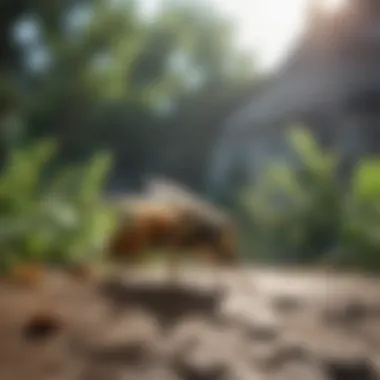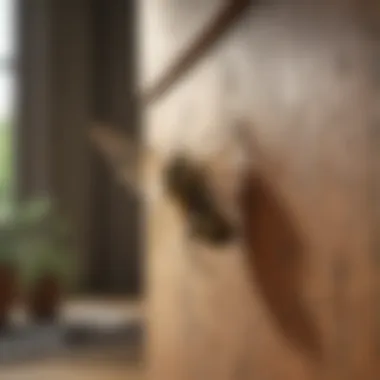Effective Strategies for Getting Rid of Wasps in Your House


Intro
Wasps are often seen as unwelcome visitors in homes. Their presence can cause distress, especially for those who dread their stinger. Understanding wasp behavior is key to managing their presence effectively. This article will explore practical strategies for getting rid of wasps, focusing on prevention, identification, and removal techniques.
We will also address safety concerns and ethical methods of removal. By understanding their habits and tendencies, homeowners can make informed decisions that not only eliminate wasps from their properties but also promote a peaceful environment.
Identification of Wasps
Before attempting to remove wasps, it is essential to identify them. There are various species, each with unique characteristics. The most common types found in homes include the yellow jackets, paper wasps, and hornets.
- Yellow Jackets: These wasps are recognizable by their black and yellow markings. They often build nests underground or in wall cavities. They can be aggressive, especially in late summer when food sources are scarce.
- Paper Wasps: These wasps create umbrella-shaped nests and are generally less aggressive. They can be beneficial because they prey on other pests.
- Hornets: They are larger than other wasps and tend to build their nests in trees or shrubs. Their sting can be painful, but they usually only sting when threatened.
Once the species is identified, it’s easier to choose the right removal method.
Prevention Techniques
Preventing wasps from invading your home is a practical approach. Here are some effective strategies to ensure they do not become a problem:
- Seal Potential Nesting Sites: Check for gaps and cracks around windows, doors, and foundations. Seal these openings to limit entry points.
- Maintain Cleanliness: Keep food and waste contained. Ensure trash bins are covered securely to avoid attracting wasps.
- Apply Natural Deterrents: Consider using natural repellents like peppermint oil or vinegar. Spraying these around the house can discourage wasps.
"Prevention is often easier than removal. Keeping your environment clean is an essential step in deterring wasps."
Removal Methods
When wasps become a nuisance, safe removal is crucial. Here are some methods to consider:
DIY Removal
- Nest Removal: If the nest is small and accessible, wait until nightfall when wasps are less active. Wear protective clothing and use a pesticide spray designed specifically for wasps. Always follow instructions carefully.
- Wasp Traps: Commercial traps can be effective. These traps attract wasps and capture them. Homemade traps using sugar water or fruit juice can also be effective.
Professional Help
For larger nests or aggressive species, it is wise to seek professional pest control services. They have the necessary equipment and experience to handle the situation safely.
Safety Considerations
Handling wasps can pose risks. Here are some important safety tips:
- Always wear long sleeves and pants when dealing with wasps.
- Keep a safe distance from nests.
- Have an escape route planned in case of a swarm.
The End
Dealing with wasps requires a combination of understanding, prevention, and safe removal techniques. Homeowners must remain vigilant and proactive. By learning the behaviors of wasps and implementing effective strategies, a peaceful indoor and outdoor environment can be maintained.
Understanding Wasps: An Overview
Understanding wasps is fundamental for anyone interested in effective pest management within their homes. Wasps are not only significant due to their potential nuisance, but they also play a role in the local ecosystem. This section provides insight into what makes wasps unique, exploring their biology and behavior, as well as the diverse species that can invade our living spaces. Knowing these aspects can help in developing targeted strategies for removal and prevention.
Biology and Behavior of Wasps
Wasps belong to the order Hymenoptera, which also includes bees and ants. They are characterized by their slender bodies and distinctive yellow and black markings, although some species may exhibit other colors. Understanding their biology is crucial for effective management. For instance, wasps are social insects, living in colonies that can contain thousands of individuals, particularly in species like the yellow jacket.
The behavior of wasps is driven by the need for food, water, and shelter. Wasps are predators and scavengers; they often feed on nectar and other insects, making them important for natural pest control. However, during late summer and fall, their diet shifts, leading them to seek out sugary foods, which can bring them closer to human activities.
In addition, wasps can become aggressive when their nests are disturbed. They possess a painful sting, which they can use multiple times, unlike bees. This aggressive behavior highlights the importance of knowing how to identify and manage wasps safely, particularly for those with allergies or sensitivities.
Different Species of Wasps
There are several species of wasps that can become problematic in residential areas. Some of the most common include:


- Yellow Jackets: Known for their aggressive nature, these wasps are often found near food sources and can invade social gatherings.
- Bald-Faced Hornets: Despite their name, they are a type of wasp. They build large paper-like nests and are known for their strong defensive behavior.
- Paper Wasps: Recognized by their long legs and open nests, they are generally less aggressive but can still pose a threat if provoked.
- Digger Wasps: These solitary wasps create burrows in the ground and are usually not aggressive, yet they can be alarming when encountered.
By understanding the different species of wasps, homeowners can better identify which species they may be dealing with and tailor their removal strategies accordingly. Each species responds differently to traps and removal methods, making this knowledge essential in achieving effective pest control.
"Understanding wasp biology and behavior is key to harmonious living with these creatures and ensuring safe removal when necessary."
Identifying a Wasp Infestation
Identifying a wasp infestation is crucial for effective pest control. Understanding how to recognize the presence of wasps in your home can lead to timely and appropriate action. Prompt identification not only minimizes discomfort and potential stings but also impedes further nesting and reproduction. Knowing the signs helps homeowners differentiate between wasps and other stinging insects. This clarity is essential for ensuring the selected removal strategy will be effective and safe.
Common Signs of Infestation
Awareness of common signs can expedite the process of identifying a wasp infestation. Here are some key indicators that may suggest wasps are present:
- Frequent Sightings: If you notice wasps flying around your house consistently, this may indicate a nearby nest.
- Nesting Material: Wasps typically use paper-like material made from wood fibers to build nests. Look for these materials in areas like under eaves or inside garage corners.
- Visible Nests: Wasps construct nests that can vary in size from small clusters to more extensive operations. They often hang from trees, gutters, or inside sheltered spaces.
The first step in managing a wasp problem is recognizing these signs. Ignoring them can lead to an increasing population and a larger issue down the line.
Locating Wasp Nests
Once signs of an infestation are suspected, the next step is locating the wasp nests. Finding these nests is essential for effective removal. Here’s how to identify potential nesting spots:
- Observe Flight Patterns: Watch the direction where wasps are flying. They typically leave and return to their nest in a straight line. This can give you clues about their nesting site.
- Check Common Areas: Look in areas that are sheltered and have easy access to food sources. This includes:
- Nighttime Observation: Wasps are less active during the night. Doing a careful nighttime inspection can help locate nests without disturbing the insects.
- Eaves of roofs
- Under decks or porches
- Inside wall voids or attics
By taking these steps, homeowners can accurately pinpoint where wasps are nesting. This information is essential in planning removal methods and establishing preventative strategies.
Prevention Strategies
A comprehensive approach to wasp control cannot overlook the importance of prevention. By actively taking steps to reduce the likelihood of wasps establishing themselves in and around your home, you can significantly mitigate future complications. Effective prevention strategies not only safeguard your living space but also enhance your outdoor experience, whether you are gardening, hosting gatherings or simply enjoying the fresh air.
When you understand and implement these strategies, you create an unfriendly environment for wasps. The focus is both proactive and reactive, ensuring that potential problems are addressed before they escalate.
The benefits of preventive measures are twofold:
- Minimizes the number of wasps near your property.
- Reduces the chances of unpleasant encounters, thus protecting family and pets.
Let’s dive into some specific strategies you can adopt to keep wasps at bay.
Sealing Entry Points
One of the most effective steps in wasp prevention is sealing potential entry points around your home. Wasps often seek shelter in hidden areas, such as attics, basements, and garages. Inspect your property for cracks, crevices, or holes that could provide access. Use weather stripping, caulk, or mesh to block these entryways. Regular maintenance is necessary, as wear and tear can create new openings over time.
- Common entry points to check:
- Windows and door frames
- Vents and exhaust fans
- Light fixtures in outdoor spaces
Additionally, be mindful of screens. Damaged or torn screens can make it easier for wasps to enter your home. Replacing or repairing such screens is a simple yet effective way to deter unwanted intruders.
Eliminating Food Sources
Wasps are attracted to food sources, making it important to eliminate any possible temptations. This includes both outdoor and indoor areas.
To avoid attracting wasps, consider the following actions:
- Outdoors:
- Indoors:
- Keep garbage bins covered and secured.
- Clean up food spills immediately, especially during outdoor events.
- Avoid leaving pet food outside.


- Store food in airtight containers.
- Clean surfaces regularly to remove crumbs or sugar residue, which can entice wasps.
By maintaining a clean environment and proper food storage practices, you reduce the likelihood of attracting wasps to your home.
Landscape Choices that Deter Wasps
Your garden and outdoor spaces can significantly influence the presence of wasps. Certain plants are more appealing to these pests, while others may deter them. Consider incorporating landscape choices that naturally resist wasp attraction.
- Avoid planting species that attract wasps:
- Eucalyptus trees
- Fruit trees
- Certain flowering plants like daisies and sunflowers
Instead, consider low-attractiveness plants, such as:
- Mint
- Sage
- Thyme
In addition to plant selection, keeping your garden tidy can help. Removal of fallen fruits and regular pruning can discourage wasps from nesting nearby. Planting herbaceous perennials or placing fresh herbs around entryways may also provide an extra layer of deterrence.
Regular preventive measures can significantly reduce the hassle of dealing with wasps later on.
Safe Removal Techniques
When dealing with wasps in your home, employing safe removal techniques is crucial. Using inappropriate methods can lead to aggressive behavior from wasps or harm to you and the environment. Understanding safe techniques can help reduce risks and provide peace of mind for homeowners.
DIY Removal Methods
Homeowners often prefer DIY removal methods due to convenience and perceived control over the process. One sensible approach involves making a simple homemade spray using dish soap mixed with water. This method is effective in suffocating wasps upon contact. Another technique is vacuuming, where a special wasp vacuum can help capture individual wasps, making it a low-impact option.
However, care must be taken when implementing these methods. Always ensure the surrounding area is clear of individuals, especially children, and pets. If the nest is large or located in a tricky spot, it might be best to reconsider DIY methods.
Chemical Solutions: When and How to Use
Chemical solutions can sometimes be the most effective and quick way to remove wasps. Products designed specifically for wasp control are available widely. When using chemicals, it is important to follow the instructions precisely. Timing is likewise critical; evening or early morning, when wasps are less active, is typically the best time for application.
Before using such solutions, consider the area around the infestation. Nearby gardens or homes may be adversely affected. Choose targeted methods that minimize broader environmental impact. Safety gear like gloves and masks should always be worn to protect from accidental exposure.
Traps: An Effective Option
Wasp traps are another viable solution for managing wasp populations. They work by attracting wasps using enticing substances like sugar water or specific lures, ensuring that trapped wasps cannot escape. Traps can be placed at strategic locations away from human activity. This reduces the likelihood of bee encounters while providing gradual control of the wasp population.
It is essential to keep traps in good condition and monitor them frequently. Empty and clean the traps regularly to enhance their effectiveness. Besides, using multiple traps can increase the chances of capture, especially during peak seasons when wasp activity is high.
"Using effective and safe removal techniques enables homeowners to manage wasp issues without putting themselves or their neighbors at risk. Understanding both DIY methods and traps can lead to successful outcomes."
Dealing with Large and Aggressive Nests
When it comes to wasp control, dealing with large and aggressive nests is a significant concern for many homeowners. These nests can house hundreds, if not thousands, of wasps, creating a serious risk of stings and other related hazards. Understanding the importance of addressing these nests safely and efficiently can help protect the home environment.
Large nests are often constructed in areas that can be challenging to access, such as attics, eaves, or dense shrubbery. Additionally, the size of the nest can exacerbate the aggression level of these insects. As their population grows, wasps become more defensive of their territory. Knowing how to identify when a nest has reached this stage is crucial.
It is vital for homeowners to assess the situation calmly. If the nest is too large or is located in a risky area, calling for professional pest control services may be the safest option. The benefits of addressing large nests correctly include reducing the risk of injury and preventing future infestations.
When to Call Professionals
Not all wasp nests require professional intervention, but certain situations clearly indicate the need for expert help. If you notice any of the following circumstances, it’s wise to consider professional assistance:
- Size of the Nest: A large, established nest can pose significant danger. If it becomes overwhelmingly large, you should not attempt to handle it alone.
- Location: If the nest is situated in a high or hard-to-reach area, such as under the roof eaves or inside a wall cavity, a pest control expert will have the tools and experience to address the problem safely.
- Aggressive Behavior: If you observe wasps aggressively defending their nest, this signifies that they are highly protective. Untrained individuals could provoke them, resulting in severe stings.
- Allergic Reactions: Should someone in your home have a known allergy to wasp stings, it’s best to have professionals manage the situation.
Professionals can use safer techniques and personal protective equipment that may not be available to DIY removal attempts. This often results in a more effective resolution.


Evaluating Potential Risks
Assessing the potential risks of wasp elimination is critical before proceeding with any course of action. Homeowners should evaluate the following elements:
- Injury Risk: Direct interaction with wasps during removal attempts poses a risk for stings. This is especially concerning for individuals allergic to wasp venom.
- Property Damage: Attempts to remove a wasp nest can lead to unintended damage to the structure of the home. Professionals typically minimize damage during their removal process.
- Reinfestation Potential: Sometimes, removal may simply lead to relocated wasps. Understanding this can help in choosing the right strategies for long-term control.
- Environmental Impact: Some chemical solutions and removal methods may harm non-target species, including beneficial insects in your garden. Careful consideration of the chosen approach is critical.
Post-Removal Considerations
Addressing wasp infestations can be a challenging task. However, the work does not end after the removal process. Post-removal considerations play a significant role in ensuring that your home remains free from these pests in the future. This section outlines important aspects to keep in mind following wasp removal, which includes monitoring the area and preventing future infestations.
Monitoring the Area
After successfully getting rid of wasps, monitoring the area is crucial. This step involves regular checks of the spots where the nests were located. Wasps can return if they perceive a safe environment. To monitor effectively, you should:
- Inspect the area regularly for any signs of new nests or activity.
- Use a practical approach to document changes in wasp behavior and their returning patterns over time.
- Look for wasp activity around areas where food and waste might be present, as these can attract a new generation of wasps.
If you notice any signs of wasp presence, such as sightings or new nests, take action promptly. Early detection can lead to more effective control measures, reducing the need for extensive removal efforts later.
Preventing Future Infestations
Preventing future infestations is essential for long-term success. Several strategies can be implemented to make your property less appealing to wasps. Consider these methods:
- Seal Entry Points: Check for cracks and gaps in walls, windows, and doors. Proper sealing can deter wasps from gaining entry into your home.
- Manage Food Sources: Keep food waste sealed in bins and ensure that outdoor eating areas are cleaned regularly. Wasps are attracted to food remnants.
- Landscape Wisely: Certain plants attract wasps. Avoid planting flowering plants like yellow flowers and fruits that produce scents appealing to these pests. Instead, consider plants known to deter wasps.
By implementing these prevention strategies, you make your property less hospitable for wasps, reducing the chances of a repeat invasion.
Monitoring and prevention must be regular efforts to safeguard your home from wasps. This adds a layer of defense that complements effective removal techniques.
Each of these steps can create a hostile environment for wasps, thereby ensuring that your home stays free from these pests. Understanding and managing the factors that contribute to wasp infestations can lead to a peaceful living space once more.
Ethical Considerations
The topic of ethical considerations in pest control is increasingly relevant, especially in discussions surrounding wasp removal. An ethical approach aims to find a balance between human comfort and the well-being of these insects. Understanding the implications of wasp removal is crucial for homeowners who may face infestations. Focusing solely on elimination can have negative consequences on local ecosystems and the species involved.
One key element of ethical wasp management is recognizing the benefits that these insects provide. Wasps are pollinators, contributing to the health of gardens and ecosystems. Instead of resorting to lethal methods, homeowners should consider alternatives that prioritize non-lethal approaches. Engaging with nature in a respectful manner promotes ecological balance.
Non-Lethal Removal Options
Many non-lethal options are available for removing wasps. These methods focus on deterring wasps rather than exterminating them. Most homeowners can implement these strategies without much effort.
- Homemade Deterrents: Simple mixtures such as water and dish soap can create a repellent when sprayed around common nesting areas.
- Natural Traps: Using sugar water in a bottle can capture wasps without killing them, allowing for relocation instead.
- Strategic Plant Choices: Certain plants, like mint, act as natural repellents. Planting them around your home can deter wasps.
- Cutting Off Food Sources: By covering trash bins and removing outdoor food, you limit the attractants for wasps.
These methods allow homeowners to manage pests with minimal harm. Respecting the natural role of wasps while still addressing infestations can lead to a more harmonious living space.
The Role of Wasps in the Ecosystem
Wasps play a vital role in the ecosystem, often overlooked in discussions about pest control. They serve as natural pest controllers, preying on insects that may damage gardens or crops. This predatory behavior helps keep insect populations balanced.
Additionally, many species of wasps are important pollinators. They assist in the pollination of various plants, contributing to plant reproduction and biodiversity. Understanding their role enhances the appreciation of these insects beyond their nuisance factor, prompting homeowners to consider their value in the environment.
In summary, acknowledging wasps’ ecological importance is essential. Non-lethal removal options align with ethical considerations, ensuring that homeowners can manage wasp nuisances responsibly while preserving the integrity of local wildlife.
Culmination
In addressing the issue of wasps in residential spaces, it becomes clear that understanding and addressing the matter comprehensively is crucial. This section highlights the importance of the various strategies discussed throughout the article. The effective management of wasp populations does not just involve removal but vigilance in preventing future infestations.
Recap of Key Points
- Understanding Wasp Behavior: Knowledge of wasp biology is essential for effective control. Understanding their habits aids in both prevention and removal efforts.
- Identification Techniques: Recognizing signs of infestation and locating nests are foundational skills for homeowners. These tactics pave the way for timely intervention.
- Prevention Steps: Emphasizing the sealing of entry points and eliminating food sources offers a proactive approach that is often more beneficial than reactive solutions.
- Safe Removal Methods: Options for safely removing wasps, whether through DIY approaches or chemical means, allow for respectful coexistence without unnecessary harm.
- Professional Intervention: Knowing when to consult pest control experts is vital, especially for larger or more aggressive nests.
- Ethical Considerations: Non-lethal methods for wasp removal underscore a commitment to respecting local ecosystems while managing pests.
Final Thoughts on Wasp Control
Navigating the complexities of wasp control in one's home requires a well-rounded understanding of their behavior, identification, prevention methods, and removal techniques. Homeowners should not view wasp infestations merely as a nuisance but as a challenge that can be effectively managed with the right knowledge and skills.
Ultimately, the goal is to create a peaceful living environment while maintaining awareness of ecological dynamics. Through informed choices, readers can minimize risks and encourage a balance between human spaces and natural wildlife. Thus, wasp control transcends mere removal; it becomes a matter of education, respect, and thoughtful stewardship of one’s home and surrounding environment.
Effective wasp management is not merely about ridding your space of pests; it's about integrating knowledge, prevention, and ethical practices into daily life.



